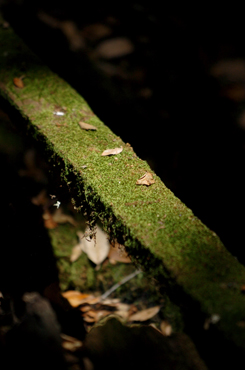
Exploring South Valley Backroads
At first, the name Nisene Marks might not evoke an individual
but rather images of prehistoric native tribal markings along a
cliffside. But this state park was, in fact, named for Danish
immigrant Nisene Marks. It was her family who, in 1963, with the
help of the Nature Conservancy, donated this serene, wooded
property to the state in her honor.
Exploring South Valley Backroads
At first, the name Nisene Marks might not evoke an individual but rather images of prehistoric native tribal markings along a cliffside. But this state park was, in fact, named for Danish immigrant Nisene Marks. It was her family who, in 1963, with the help of the Nature Conservancy, donated this serene, wooded property to the state in her honor.
Maintaining the area’s redwood-forested aspect was part of the family’s requirement: the wilderness-like 10,000 acres was to be left undisturbed, so the second-growth process could continue. With assistance from the Save the Redwoods League, additional acreage has been purchased over the years to add on to the Marks family’s generation donation.
Second-growth restoration has been going on at this park ever since the lumbering stopped. From 1883 until 1923, the Loma Prieta Lumber Company worked the virgin forest, taking out an estimated 140 million board feet of redwood lumber in the process of its 40-year operation.
Today, the steep, creek and trail-laced acreage, located on southern slope of the Santa Cruz Mountains, welcomes hikers, campers, nature enthusiasts and fresh-air buffs seven days a week. Some come to walk the trails, ford the park’s creeks, and head up through part of the 30 miles of trails, some of them easy, others rugged. Others prefer to just sit and relax for a while, enjoying an alfresco picnic under the canopy of a spreading sequoia sempervirens.
For the hearty strider, there’s the 7- to 9-mile Maple Falls trail hike. Beginning on the Aptos Creek Fire Road, the main pathway leading into the heart of the park, the Loma Prieta Grade Trail leads through thick growth to the Bridge Creek Historic Site, then a hard tramp up Bridge Creek and through a canyon to view the 40-foot falls, running full after seasonal rains, less as the year wears on.
On a calmer note, it’s perfectly possible to spend part of a day here just wandering closer in to headquarters. Along the Bridge Creek Historic site, for example, lie the remains of the old company town, left from the logging days.
In the tranquil, forested ambiance, it’s hard to imagine that, until 80 years ago, the area was alive with the din of steam donkeys, the buzz of milling lumber, the sounds plodding ox hooves thudding along the forest floor hauling creaking wagons filled with the day’s hewn logs. Remains of old trestles still found along the trails today are silent testimony left over from the days when a small train on a narrow rail transported its log quota from deep within the forested acres.
A relatively easy, 1.5-mile hike from the Porter Family Picnic Area leads across a footbridge to a deceptively innocent-looking grove. It was not so calm here on Oct. 19, 1989, when the spot turned into the epicenter of the 7.1-magnitude Loma Prieta Earthquake. The temblor was so-called for section on the San Andreas Fault where it occurred: Loma Prieta is the highest peak in the Santa Cruz Mountain chain along this section.
For a long time following the disastrous quake, which toppled bridges and upheaved local highways, downed trees lay in jumbled heaps in the wooded environs at the Forest of Nisene Marks. Nature, ever healing itself, has grown over the damaged area, once more returned to its peaceful state. Here, and along the trail leading to the epicenter site, hikers will also find stands of second-growth redwoods, growing from the felled stumps of their ancestors, some of them over a millennium in age before the logging company came through.
The most strenuous hike at the Forest of Nisene marks is the West Ridge and Aptos Creek Loop, a 12.5 mile trek can take two days if hikers include an overnight stop at the West Ridge Trail Camp, with close access to the 1,500-foot Sand Point Overlook and some grand views. This is a primitive campsite with no amenities; hikers must provide camp stoves, and water, and make reservations in advance.
Besides the scenic hikes and forested serenity, there’s plenty of flora and fauna to admire at this state park. Still in the healing process from the decades of logging stress, the original the plant growth zones extended from chaparral along the dry, sun-drenches ridges, with growths such as knobcone pine and manzanita, down through a mixed evergreen forest area of tan oak and madrone along the mid-slopes, to redwood forests in the dark, damp canyons. Maples and alder, then as now, line the creeks. Animal life here ranges from mountain lions, foxes and deer to raccoons and chipmunks, and everywhere, the inevitable, squawking jays.
With time to spare after a quiet tramp beneath the redwoods at the Forest of Nisene Marks, there’s always quaint little Aptos to visit. Located practically next door to the park entrance, the village offers cafes and shops, all awaiting exploration and browsing. Beyond, just across the highway, the sea and sand of Seacliff State Beach offer a wrap-up to a long day away. Here, visitors can pause to watch the sun slip into the Pacific while the seagulls wing past, as life in the nearby forest settles down for an evening’s rest.
GETTING THERE: Follow Highway 1 to Aptos, exit at the Aptos-Rio del Mar exit, then follow Soquel Drive into Aptos Village. At Aptos Creek Road, turn right to the entrance to The Forest of Nisene Marks State Park. Hours: Daily 6 AM to Sunset; for more information, write Forest of Nisene Marks State Park, Aptos Creek Road, Aptos, CA 95003; phone (831) 763-7062; or visit on-line at: www.parks.ca.gov. Camping, available on a first come-first-served basis, requires reservations. Picnic tables, barbecues available for daytrippers. Dogs on leashes permitted on the entrance trail and picnic areas. Trail maps available at kiosk.









